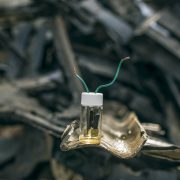Scientists are building high-performance batteries from junkyard scrap metal
Dana Varinsky Dec. 15, 2016
 Daniel Dubois/Vanderbilt Universit
Daniel Dubois/Vanderbilt UniversitOne man’s trash is another man’s battery material.
Or at least that’s the case for Cary Pint, an assistant professor of mechanical engineering at Vanderbilt University. Pint and a team of researchers recently created a small pill-bottle-sized battery using steel, brass, and a common household chemical called potassium hydroxide.
According to a paper about the new technology published in the journal ACS Energy Letters, the battery can store similar levels of energy to traditional lead-acid batteries, and charge at rates close to those of ultra-fast supercapacitators.
But unlike those batteries, this one can be made cheaply, and without what Pint refers to as “nasty chemicals.”
“I certainly wouldn’t want to stick a lead acid battery behind my house with my infant and my toddler hanging around,” he explains on the latest episode of Codebreaker, the podcast Business Insider produces with Marketplace. “The way to get past that is to build your own system.”
With renewable energy sources becoming more accessible and affordable for consumers — the cost of building a solar photovoltaic plant has fallen by about 80 percent since 2009 according to a Brookings Institution analysis — figuring out cheap ways to store the energy they gather is becoming an increasingly important challenge.
Pint’s vision is that his affordable scrap-metal battery could one day be connected to a building’s solar cell (the device that converts the sun’s radiation into electricity) and store energy that can be used when it’s dark or cloudy.
Daniel Dubois/Vanderbilt Universit
“Photovoltaics and solar cells give you on-demand power. The bottleneck right now is, well, where are the cheap batteries?” Pint says on Codebreaker.
To make the scrap metal batteries, Pint’s team used a process called anodization, which is more commonly employed to decorate a metal surface like aluminum and make it corrosion-resistant. That caused iron oxides to form on the steel and copper oxides to form on the brass. They then put the treated metals into a glass jar and filled it with a potassium hydroxide solution (an inexpensive salt used in laundry detergent), and produced a functional battery.
“This is the first time that anybody has ever put those two materials together in a battery,” Pint says.
The team tested the battery over 5,000 charging cycles — roughly 13 years worth of daily charging and discharging — and afterward found that it still had more than 90 percent of its capacity.
The next step is to build a full-scale prototype, but Pint hopes his discovery could lead to more than an affordable energy-storage system. Because the materials are easily sourced and the process of making the battery is not overly complicated, he sees the potential for battery building to be incorporated into DIY or maker culture.
“I believe we will see the day when residents will disconnect from the grid and produce their own batteries,” he says.
In that case, the power would literally be in the hands of the people.
source:Scientists are building high-performance batteries from junkyard scrap metal




